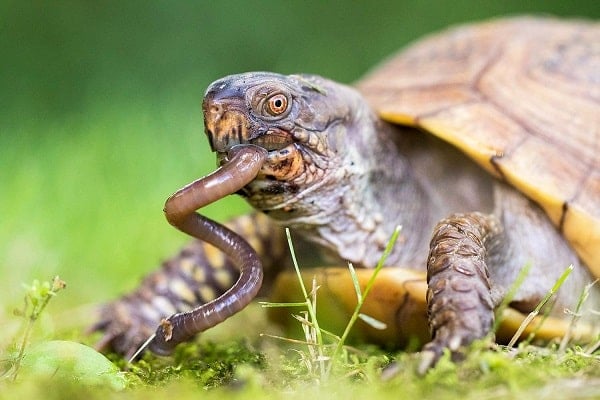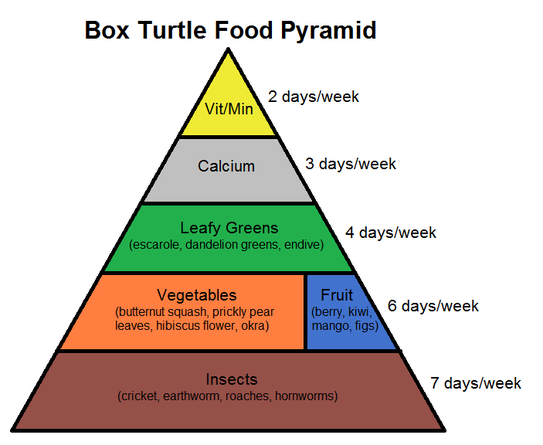You can feed your box turtle a diet consisting of vegetables, fruits, insects, and commercial turtle food. Box turtles require a balanced diet to stay healthy and thrive in captivity.
Providing a variety of foods ensures they receive essential nutrients for their overall well-being. In the wild, box turtles feed on a diverse range of foods, including plants, insects, fruits, and even small animals. When kept as pets, it is essential to replicate this natural diet to keep them healthy.
By offering a mix of vegetables like leafy greens, carrots, and squash, along with fruits such as berries and melons, you can ensure your box turtle has a nutritious and balanced diet. Additionally, offering live insects like crickets and mealworms can provide essential protein and enrichment for your pet. Remember to dust insects with a calcium supplement to support your box turtle’s shell and bone health. Commercial turtle food can also be a part of their diet, but it should not be the sole source of nutrition. Be sure to consult with a reptile veterinarian for specific dietary recommendations based on your box turtle’s individual needs.
:strip_icc()/eastern-box-turtle--terrapene-carolina--eating-strawberries-michigan-128111863-5c3e137dc9e77c000118e739.jpg)
Credit: www.thesprucepets.com
Box Turtle Diet Basics
Box turtles are omnivorous creatures that require a well-balanced diet to thrive. Understanding the basics of their dietary needs is crucial for the health and longevity of these captivating reptiles. Whether in their natural habitat or in captivity, providing the right nutrition is essential for their well-being.
Natural Diet
In the wild, box turtles have a varied diet that consists of a mix of plant matter and protein sources. They forage for fruits, berries, vegetables, and leafy greens, along with insects, worms, snails, and small invertebrates. This diverse diet provides the essential nutrients and minerals they need to stay healthy and active.
Captivity Diet
When kept as pets, box turtles should be offered a diet that replicates their natural feeding habits. This includes a combination of leafy greens, such as kale, collard greens, and mustard greens, along with fruits like strawberries, apples, and melons. Additionally, providing protein sources like mealworms, crickets, and earthworms is vital for their overall well-being.

Credit: www.boxturtles.com
Best Foods For Box Turtles
Ensuring a well-rounded diet is crucial for the health and longevity of your box turtle. Here are the best foods to include in their diet:
Vegetables
- Dark leafy greens such as kale and collard greens
- Carrots for Vitamin A
- Bell peppers for Vitamin C
Fruits
- Berries like strawberries and blueberries
- Melons such as cantaloupe and watermelon
- Bananas for potassium
Proteins
- Mealworms or crickets as occasional treats
- Boiled eggs for a protein boost
- Snails or earthworms for natural protein sources
Supplements And Treats
Ensure your box turtle’s diet includes a mix of vegetables, fruits, insects, and commercial turtle food. Offer a variety of supplements like calcium and vitamin D3, and occasional treats such as earthworms or mealworms to keep your pet healthy and happy.
Box turtles are omnivores, which means they need a balanced diet that consists of both meat and plant-based foods. In addition to their regular meals, box turtles can benefit from supplements and occasional treats to keep them healthy and happy. Let’s take a closer look at two essential supplements and some tasty treats that your box turtle will love.Calcium And Vitamin D3
One of the most crucial supplements for box turtles is calcium with vitamin D3. Calcium is essential for the development of strong bones and healthy muscles, while vitamin D3 helps the body absorb calcium effectively. Without enough calcium and vitamin D3, your box turtle can develop metabolic bone disease, which can be fatal. You can provide calcium and vitamin D3 supplements to your box turtle by dusting their food with a powdered supplement or offering a cuttlebone or calcium block for them to nibble on.Occasional Treats
While box turtles need a balanced diet, they can still enjoy occasional treats. Treats can be a great way to encourage your turtle to eat new foods or to provide them with some enrichment. However, treats should only make up a small portion of your turtle’s diet to avoid weight gain or nutrient deficiencies. Some examples of healthy treats for box turtles include:- Fruits like strawberries, mango, and papaya
- Vegetables like carrots, green beans, and squash
- Protein sources like mealworms, crickets, and cooked chicken
Foods To Avoid
When it comes to caring for your box turtle, it’s crucial to be mindful of the foods you offer. Some items can be harmful to your pet’s health. Here are some foods to avoid:
Toxic Plants
Box turtles should never consume toxic plants as they can cause severe health issues. Avoid offering any plants from the following list:
- Lilies
- Daffodils
- Rhubarb leaves
High-fat Foods
High-fat foods can lead to obesity and other health problems in box turtles. It’s important to steer clear of high-fat foods such as:
- Avocados
- Fatty meats
- Cheese
Feeding Techniques
Feeding techniques play a crucial role in the health and well-being of your box turtle. With the right feeding schedule and methods, you can ensure that your pet receives the proper nutrition it needs to thrive. Here, we’ll explore the best feeding techniques for box turtles, including feeding schedule and methods to help you take the best care of your pet.
Feeding Schedule
Box turtles should be fed daily, especially during the warm months. Young turtles may require daily feeding, while adult turtles can be fed every other day. It’s essential to monitor their eating habits and adjust the feeding schedule accordingly.
Feeding Methods
- Live Prey: Offer live insects, such as crickets, mealworms, and earthworms, to mimic their natural hunting behavior.
- Commercial Diets: High-quality commercial turtle pellets and moistened dog food can provide essential nutrients.
- Fruits and Vegetables: Offer a variety of fresh fruits and vegetables, such as leafy greens, carrots, and berries, to supplement their diet with vitamins and minerals.
- Calcium Supplementation: Dust their food with calcium powder to ensure proper shell and bone development.
Hydration Needs
Ensure your box turtle’s hydration needs are met by offering a variety of fresh fruits, vegetables, and insects. Providing a shallow water dish for drinking and soaking is essential for their overall health and well-being. Keep their diet diverse to maintain optimal hydration levels.
Water Sources
Box turtles need access to clean, fresh water at all times. They can drink from a shallow dish or even from a water bottle with a dropper. It is important to change the water daily to prevent the growth of bacteria and other harmful organisms.Misting And Soaking
In addition to drinking, box turtles also absorb water through their skin and cloaca. Misting their enclosure with a spray bottle or providing a shallow water dish for soaking can help them stay hydrated. Soaking also helps them maintain healthy skin and shells.Additional Tips
– Avoid using tap water as it may contain chlorine and other chemicals harmful to turtles. – If possible, use filtered or bottled water instead. – You can also add a small amount of reptile-safe water conditioner to the water to remove any harmful chemicals. – Make sure the water temperature is not too hot or too cold, as extreme temperatures can be stressful for box turtles. – Finally, monitor your turtle’s water intake and hydration levels regularly to ensure they are healthy and properly hydrated.Observing Eating Habits
Signs Of Hunger
Box turtles may exhibit restlessness and increased activity when hungry.
Monitoring Food Intake
Keep track of the types and amounts of food your box turtle consumes regularly.
:strip_icc()/GettyImages-557062319-571b99365f9b58857dc793aa.jpg)
Credit: www.thesprucepets.com
Consulting A Veterinarian
When it comes to the health and well-being of your box turtle, consulting a veterinarian is crucial. A qualified reptile veterinarian can provide valuable insights and guidance on ensuring the proper diet and nutrition for your box turtle. They can conduct a health assessment, offer dietary recommendations, and address any concerns related to your pet’s well-being.
Health Assessment
Before making any dietary changes or decisions, it’s essential to have your box turtle undergo a comprehensive health assessment by a reptile veterinarian. This assessment may include evaluating the turtle’s overall health, checking for any underlying health issues, and determining if there are any specific dietary requirements based on the turtle’s age, size, and overall health condition.
Dietary Recommendations
Based on the health assessment, a veterinarian can provide tailored dietary recommendations for your box turtle. This may include specific types and quantities of fruits, vegetables, insects, and commercial turtle food. They can also advise on dietary supplements, such as calcium and vitamin D3, to ensure your turtle receives all essential nutrients for optimal health.
Conclusion
To ensure your box turtle’s health, offer a balanced diet of veggies, fruits, and protein. Remember to vary their meals and provide calcium and vitamin supplements. Consult a vet for dietary advice and make sure fresh water is always available.
Keeping your box turtle well-fed is key to their overall well-being.






Leave a Reply